 |
Current Conditions
| Tropical Pacific Sea Surface Temperatures | Tropical Pacific Sea Surface Temperature Anomalies |
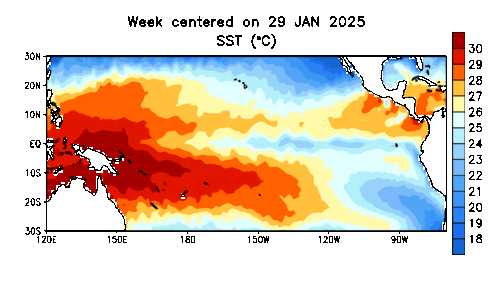 |
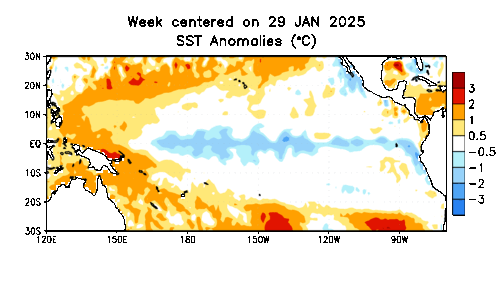 |
| Tropical Pacific sea surface temperatures (left image) and associated anomalies (right image). Notice the unusually warm strip of sea surface temperatures oriented west to east across the central and eastern equatorial Pacific Ocean, typical of El Niño conditions. | |
Quick Facts
What is El Niño and La Niña?
|
Maps of sea surface temperature anomaly in the Pacific Ocean during a strong La Niña (top, December 1988) and a strong El Niño (bottom, December 1997). Maps by NOAA Climate.gov, based on data provided by NOAA View. |
El Niño/La Niña is one of the most important climate phenomena on Earth due to its ability to change the global atmospheric circulation, which in turn, influences temperature and precipitation across the globe. We also focus on El Niño/La Niña because we can often predict its arrival many seasons in advance of its strongest impacts on weather and climate
How did El Niño get its name? Before La Niña was even recognized, South American fisherman noticed the warm up of coastal waters occurred every so often around Christmas. They referred to the warming as “El Niño,” (niño being Spanish for a boy child) in connection with the Christmas holiday. It wasn’t until the 1980s that the term La Niña gained prominence.
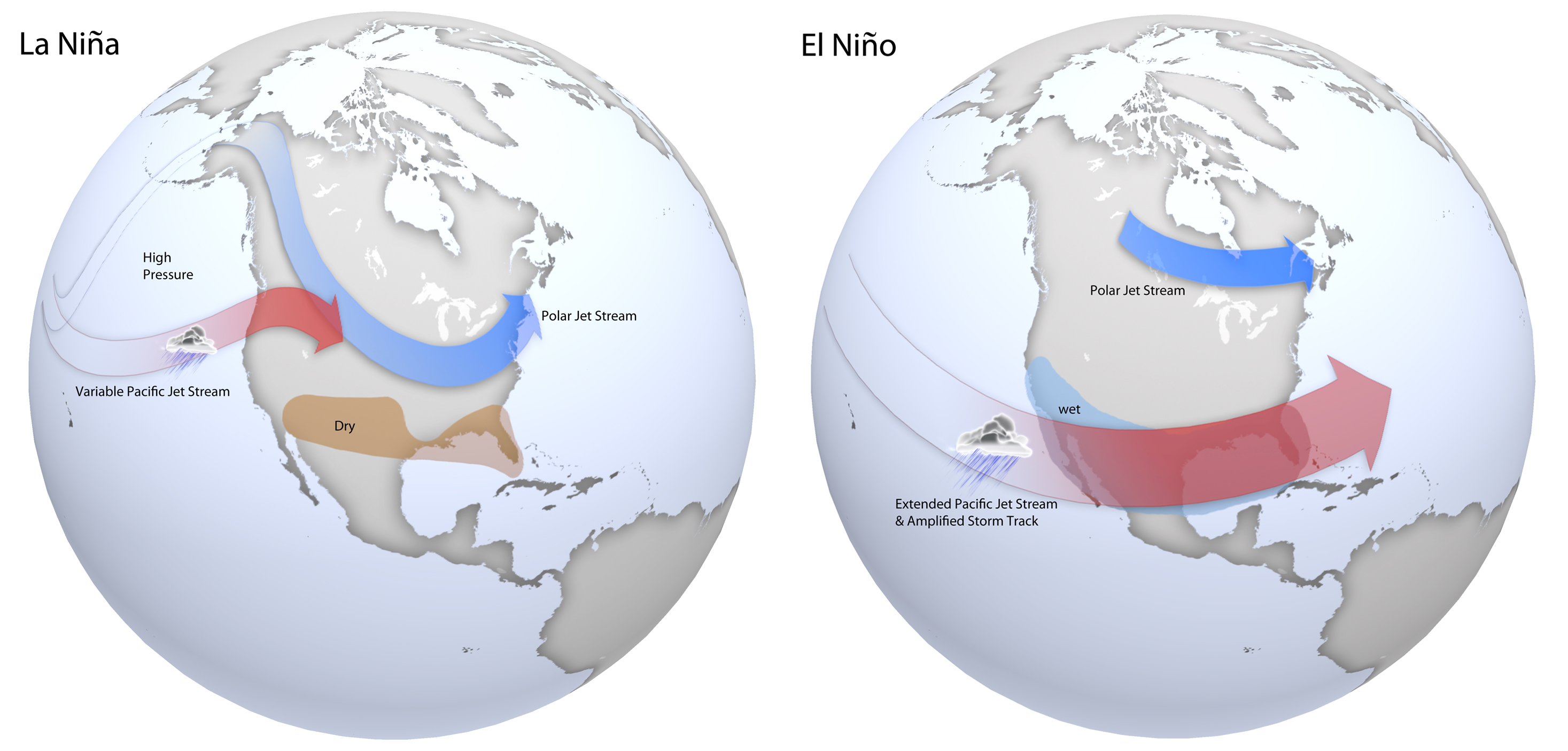 |
| Typical late fall through early spring upper level jet stream positions associated with moderate to strong La Niña (left) and El Niño (right) events. During La Niña, a variable Pacific jet stream in association with a polar jet stream shifted further south favors below normal precipitation across the southern US, with below normal temperatures across the northern US. During El Niño, a strong and amplified Pacific jet stream extending across the southern US in association with a polar jet stream shifted further north into Canada favors above normal precipitation across the southern US, and above normal temperatures over the northern US. Based on original graphics from NOAA’s Climate Prediction Center. |
Does El Niño/La Niña Impact Wisconsin Weather?
Affects from El Niño/La Niña tend to have at least a minor impact on Wisconsin's weather. Moderate and especially strong events can have more significant impacts with varying weather conditions, especially during the late fall through early to mid spring months. The following graphics depict November through March temperature and precipitation anomalies associated with nine of the strongest El Niño and La Niña episodes. These composites DO NOT represent a forecast of expected conditions.
El Niño
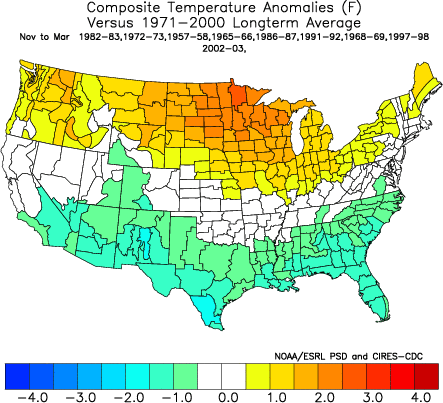 |
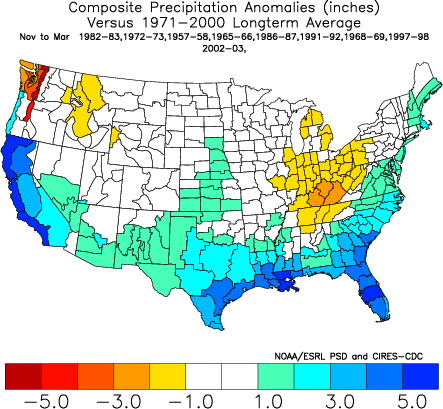 |
| November-March Temperature Anomalies | November-March Precipitation Anomalies |
These composites DO NOT represent a forecast of expected conditions. November through March temperature and precipitation anomalies determined from nine of the strongest El Niño episodes since 1950. Warm colors indicate above normal temperatures (left) and below normal precipitation (right), while cool colors indicate below normal temperatures (left) and above normal precipitation (right). Warmer-than-normal temperatures are favored across much of the Midwest. Near normal precipitation is favored statewide. Images courtesy of NOAA's Earth System Research Laboratory.
La Niña
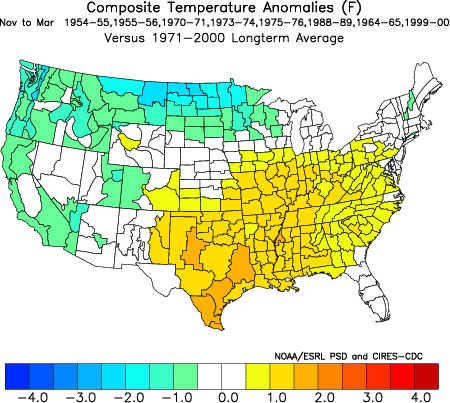 |
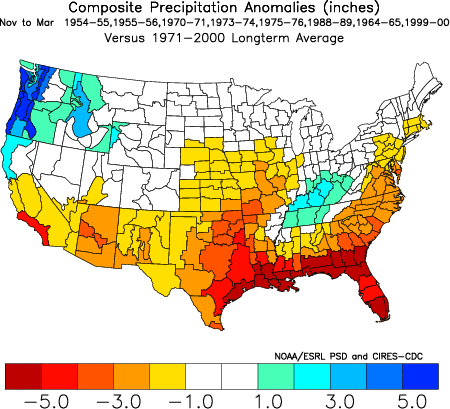 |
| November-March Temperature Anomalies | November-March Precipitation Anomalies |
These composites DO NOT represent a forecast of expected conditions. November through March temperature and precipitation anomalies determined from eight of the strongest La Niña episodes since 1950. Warm colors indicate above normal temperatures (left) and below normal precipitation (right), while cool colors indicate below normal temperatures (left) and above normal precipitation (right). Near to slightly below normal temperatures are favored across much of Wisconsin, with near or slightly below normal precipitation. Images courtesy of NOAA's Earth System Research Laboratory.
El Niño: Risk of Temperature/Precipitation Extremes
The images below depict the odds of extreme wet/dry or warm/cold fall-spring months associated with historical El Niño episodes. Extreme weather is defined as being in the highest or lowest 20% of the 100 year record. The climatological average risk of extreme weather any given season is 20%. These composites DO NOT represent a forecast of expected conditions.
El Niño: Risk of Temperature Extremes
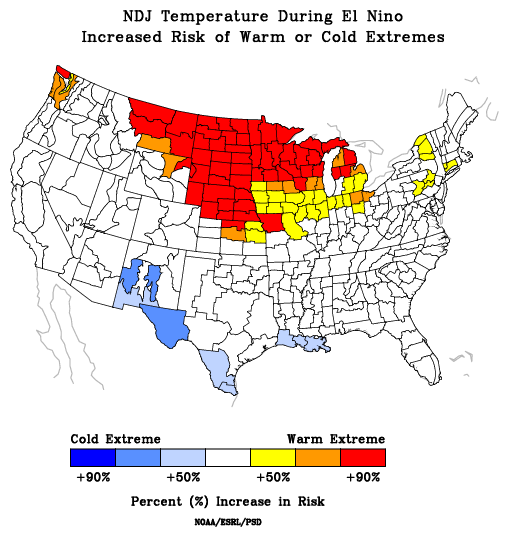 |
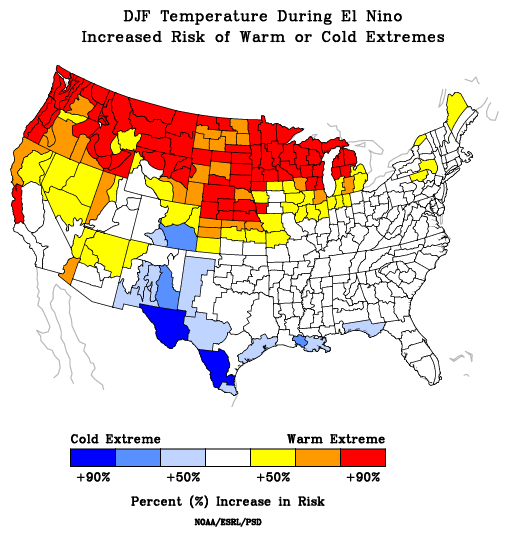 |
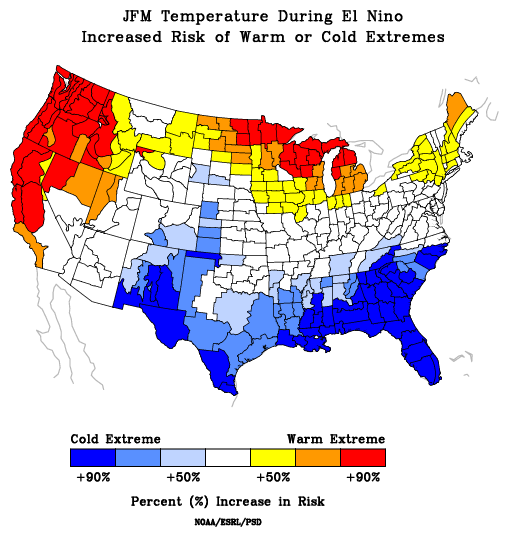 |
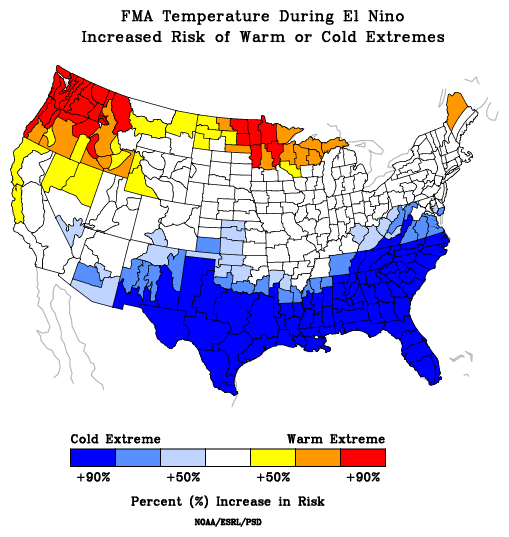 |
| November - January | December - February | January - March | February - April |
These composites DO NOT represent a forecast of expected conditions. The above four images depict the odds of extreme warm or cold fall-spring months associated with past El Niño's. Extreme weather is defined as being in the warmest or coldest 20% of the 100 year record. The climatological average risk of extreme weather any given season is 20%. Warm colors indicate an increased risk of warm temperature extremes, while cool colors indicate an increased risk of cold temperature extremes. For Wisconsin, the risk of warm temperature extremes exist over much of the state through late winter. Click images to enlarge. Images courtesy of NOAA's Earth System Research Laboratory.
El Niño: Risk of Precipitation Extremes
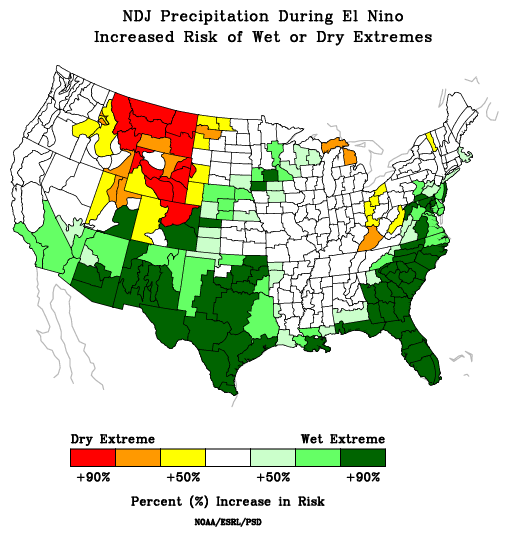 |
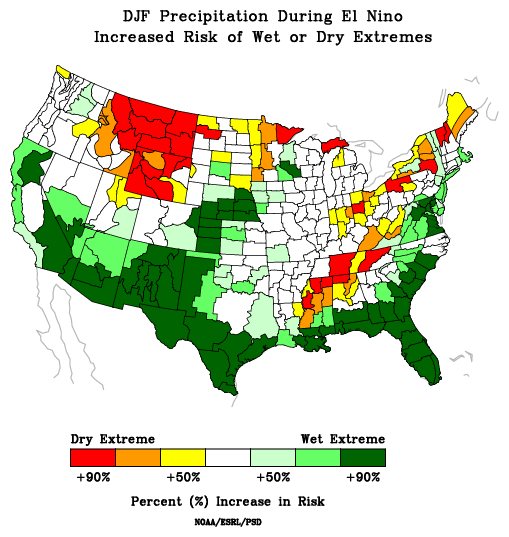 |
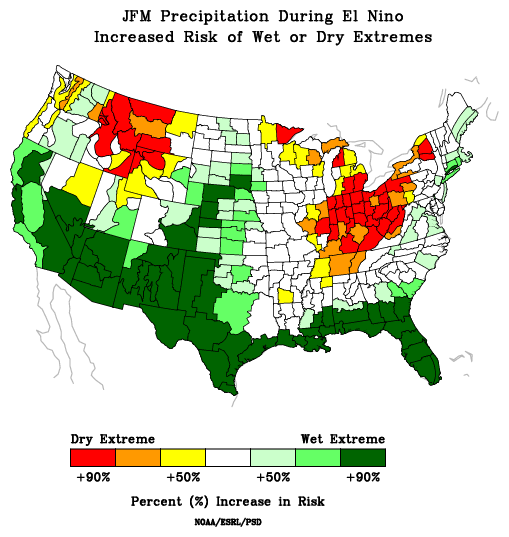 |
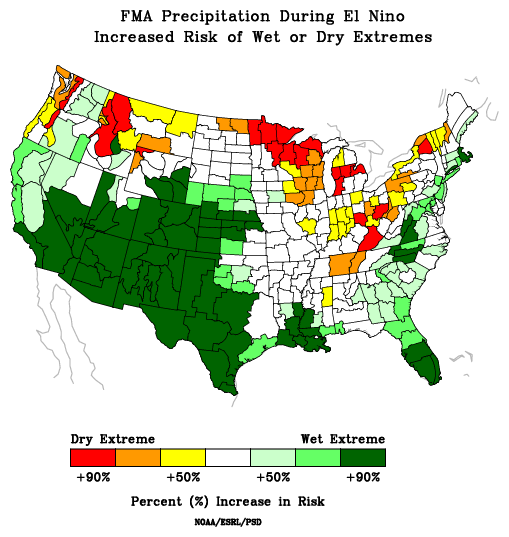 |
| November - January | December - February | January - March | February - April |
These composites DO NOT represent a forecast of expected conditions. The above images depict the odds of extreme wet or dry fall-spring months associated with past El Niño's. Extreme weather is defined as being in the wettest or driest 20% of the 100 year record. The climatological average risk of extreme weather any given season is 20%. Warm colors indicate an increased risk of dry precipitation extremes, while green colors indicate an increased risk of wet precipitation extremes. For Wisconsin, there is generally an increased risk of low precipitation extremes from late winter into spring, especially across the north. Click images to enlarge. Images courtesy of NOAA's Earth System Research Laboratory.
La Niña: Risk of Temperature/Precipitation Extremes
The images below depict the odds of extreme wet/dry or warm/cold fall-spring months associated with historical La Niña episodes. Extreme weather is defined as being in the highest or lowest 20% of the 100 year record. The climatological average risk of extreme weather any given season is 20%. These composites DO NOT represent a forecast of expected conditions.
La Niña: Risk of Temperature Extremes
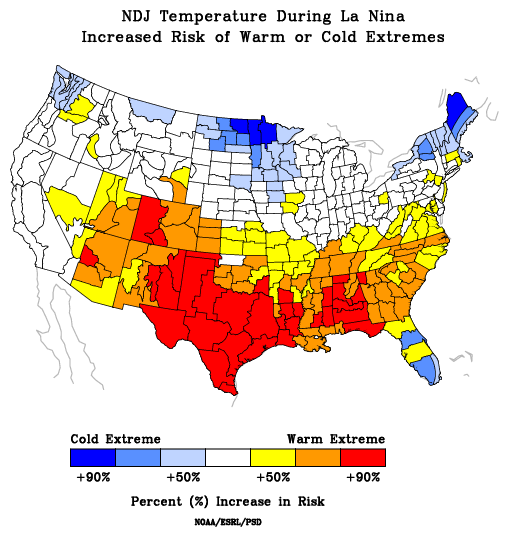 |
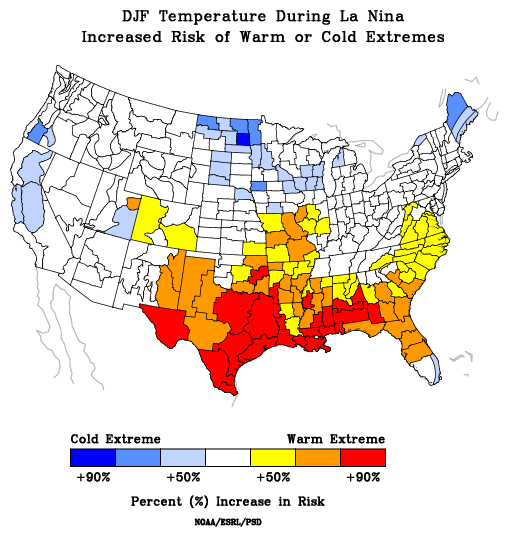 |
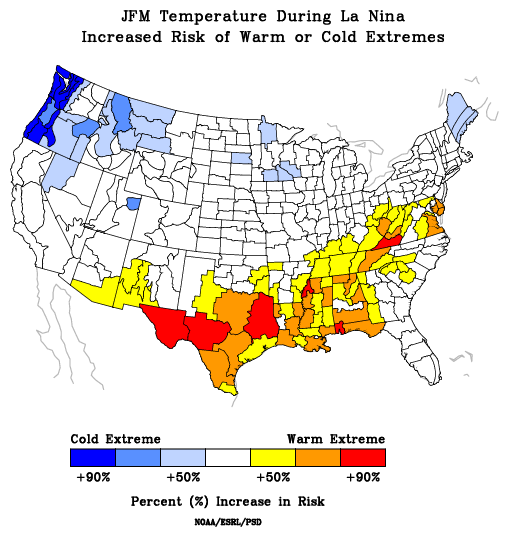 |
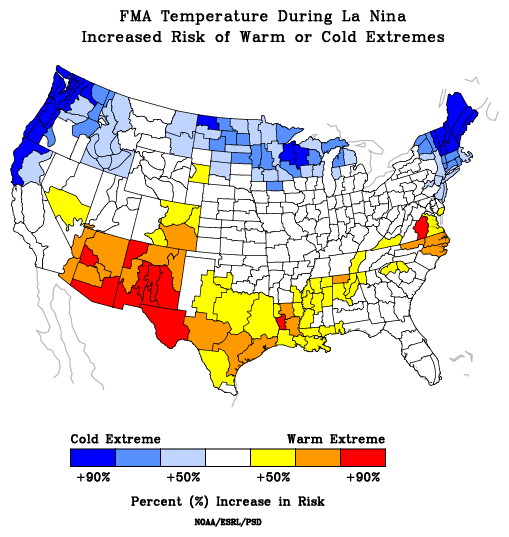 |
| November - January | December - February | January - March | February - April |
These composites DO NOT represent a forecast of expected conditions. The above images depict the odds of extreme warm or cold fall-spring months associated with past La Niña's. Extreme weather is defined as being in the warmest or coldest 20% of the 100 year record. The climatological verage risk of extreme weather any given season is 20%. Warm colors indicate an increased risk of warm temperature extremes, while cool colors indicate an increased risk of cold temperature extremes. For Wisconsin, an increased risk of cold temperature extremes exists, especially in the spring. Click images to enlarge. Images courtesy of NOAA's Earth System Research Laboratory.
La Niña: Risk of Precipitation Extremes
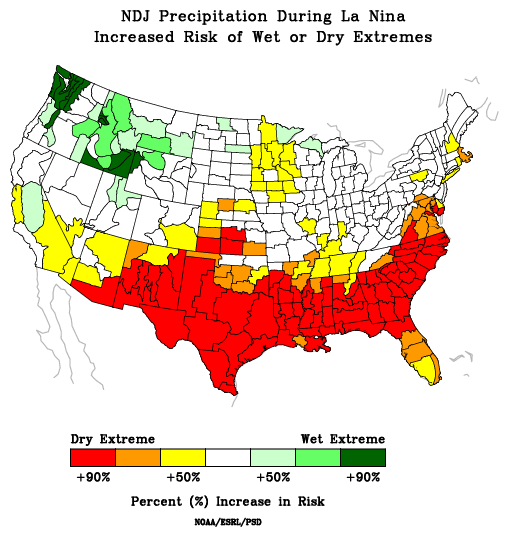 |
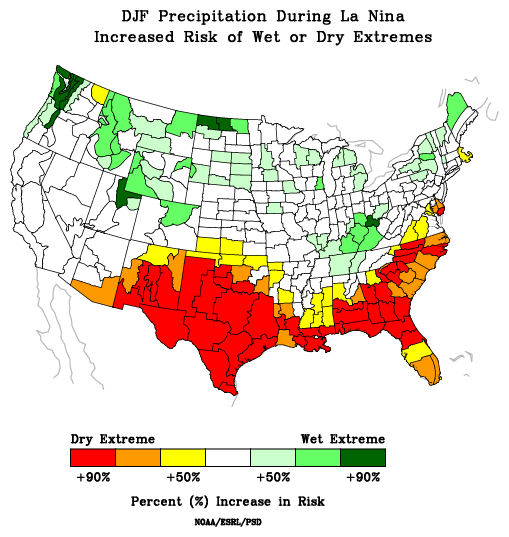 |
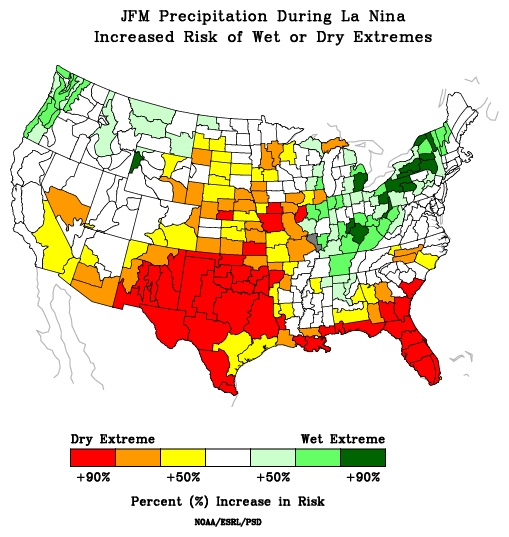 |
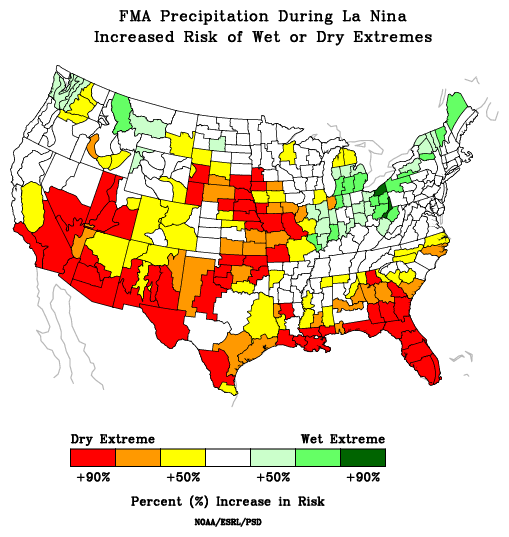 |
| November - January | December - February | January - March | February - April |
These composites DO NOT represent a forecast of expected conditions. The above images depict the odds of extreme wet or dry fall-spring months associated with past La Niña's. Extreme weather is defined as being in the wettest or driest 20% of the 100 year record. The climatological average risk of extreme weather any given season is 20%. Warm colors indicate an increased risk of dry precipitation extremes, while green colors indicate an increased risk of wet precipitation extremes. For Wisconsin, there is a relatively low risk for precipitation extremes from November through April. Click images to enlarge. Images courtesy of NOAA's Earth System Research Laboratory.
Official Long-Range Forecasts
Below are official long-range forecasts issued by the Climate Prediction Center (CPC). Professionals at CPC take into account many different factors when assembling these forecasts, including the El Niño/La Niña composites posted throughout this report.
One-Month Forecast
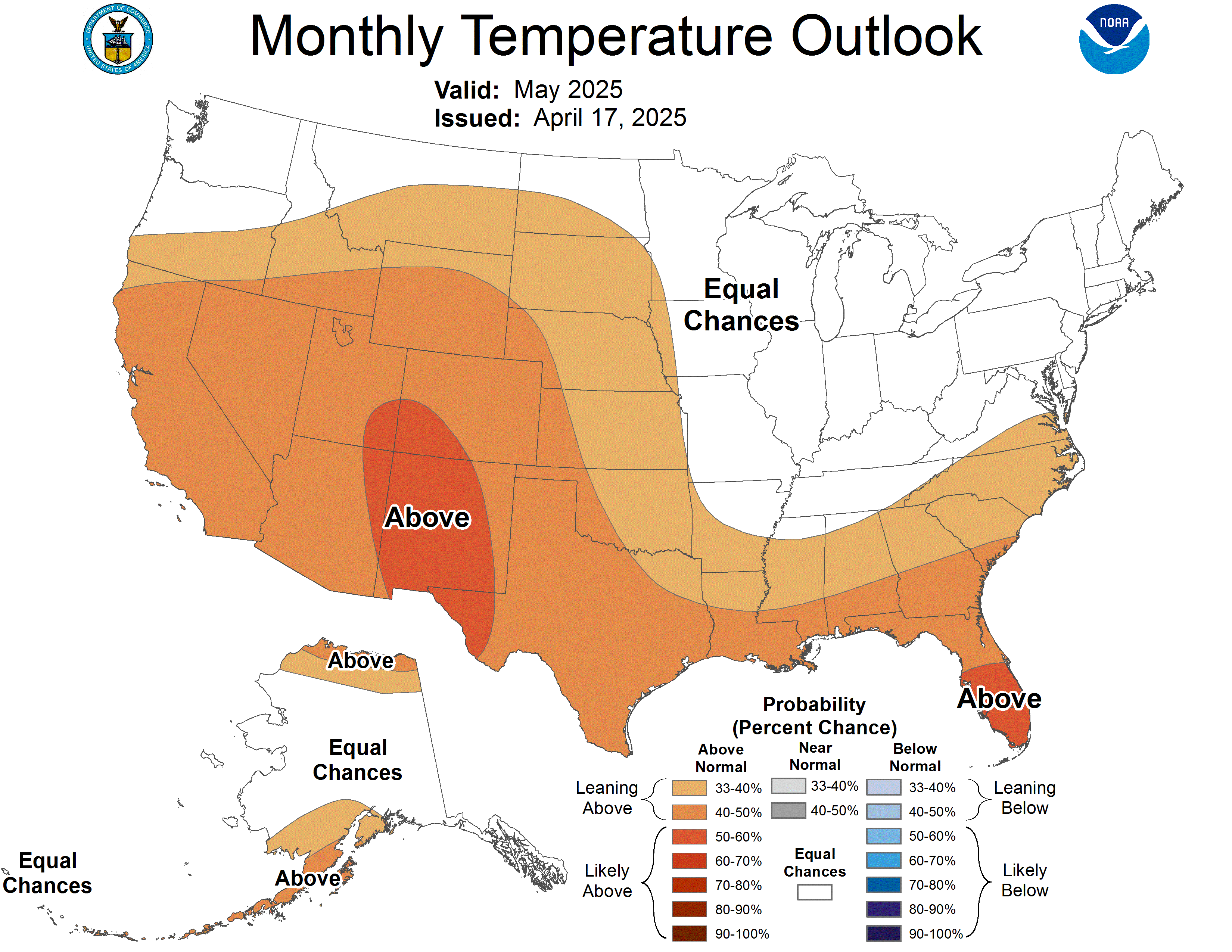 |
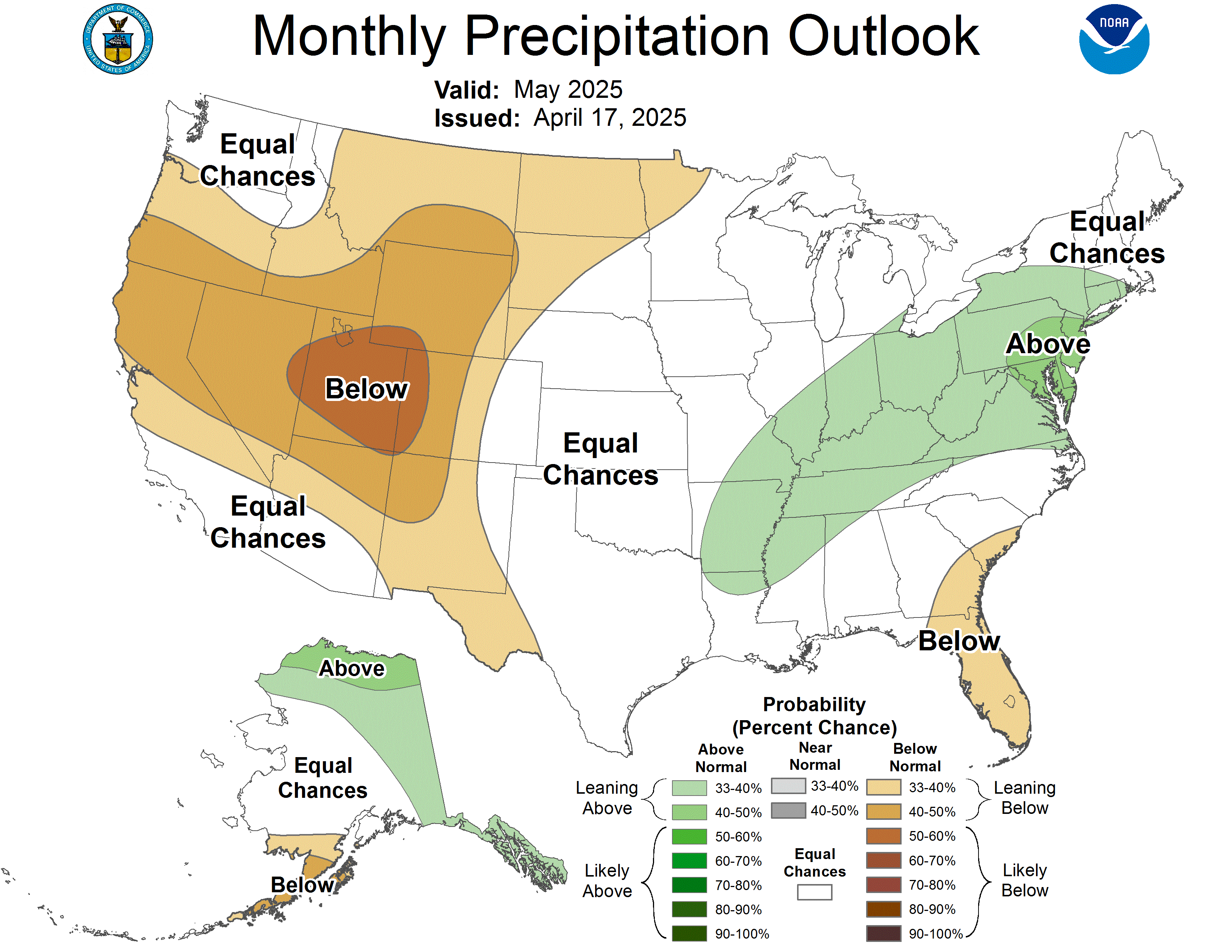 |
| Chances of Above/Below Normal Temperatures | Chances of Above/Below Normal Precipitation |
Three-Month Forecast
 |
 |
| Chances of Above/Below Normal Temperatures | Chances of Above/Below Normal Precipitation |
El Niño/La Niña & Spring Severe Thunderstorm Frequency
A paper published in Nature Geoscience in April 2015 by John Allen, Michael Tippett, and Adam Sobel examines the influence of El Niño/La Niña on springtime hailstorms and tornadoes across the contiguous United States from late winter through spring. The below images are adapted from the paper, and show tornado and hail frequencies for the spring months (March-May) during El Niño (left column) and La Niña (right column). The authors explain that the connection between El Niño/La Niña conditions and summertime storms is less clear, and unfortunately that is the time of year when severe storms peak throughout much of the United States. But for springtime, at least, El Niño/La Niña data may be able to refine seasonal severe weather outlooks.
 |
| Tornado and hail frequencies for the spring months (March-May) during El Niño (left column) and La Niña (right column). Purple favors higher storm event frequency, and brown favors lower storm event frequency. Specifics vary, but in general, springtime tornadoes and hailstorms are less frequent in the central and southern United States during El Niño, and more frequent during La Niña. Image courtesy of NOAA climate.gov. |
Additional Links/Resources